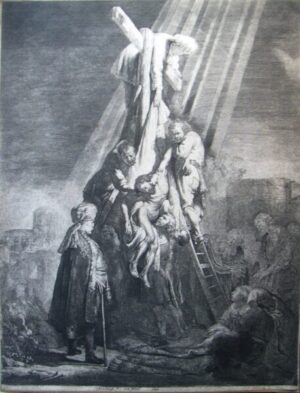Van Ryn, Rembrandt Harmensz (1606-1669)
Dutch painter, etcher, and teacher. Rembrandt was one of the most prolific and significant artists in Europe of the 17th century. Between 1629 and 1669 he painted about 60 penetrating self-portraits, many of them used as studies for later paintings. He also painted religious subjects, and produced about 300 etchings and over 1,000 drawings. His major group portraits include The Anatomy Lesson of Dr Tulp (1632; Mauritshuis, The Hague) and The Night Watch (1642; Rijksmuseum, Amsterdam). Known for his mastery of the chiaroscuro effect and the baroque style, his later work is passionate, psychologically charged, and atmospherically moody.
After studying in Leiden and for a few months in Amsterdam (with a history painter), Rembrandt began his career in 1625 in Leiden, where his work reflected knowledge of Adam Elsheimer and Caravaggio, among others. He settled permanently in Amsterdam in 1631 and obtained many commissions for portraits from wealthy merchants. The Self-Portrait with Saskia (his wife, Saskia van Uylenburgh) (c. 1634; Gemäldegalerie, Dresden) displays their prosperity in warm tones and rich, glittering textiles.
Saskia died in 1642, and that year Rembrandt's fortunes began to decline (he eventually became bankrupt in 1656). His work became more sombre, revealing a deeper emotional content, and his portraits were increasingly melancholy; for example, Jan Six (1654; Six Collection, Amsterdam). From 1660 onwards he lived with Hendrickje Stoffels, but he outlived her, and in 1668 his only surviving child, Titus, died too. Rembrandt had many pupils, including Gerard Dou and Carel Fabritius. He was buried in the Wester Kerk in Amsterdam, and his house in the city is now a Rembrandt museum.
Early influences Rembrandt was born in Leiden, the fourth son of a prosperous miller. He briefly attended Leiden University in 1620 before entering the studio of Jan van Swanenburgh in Leiden, where he spent three years, followed by a period of about six months under the history painter Pieter Lastman (1583–1633) in Amsterdam. Through these two painters, especially Lastman, and other contemporaries who had visited Italy, such as Honthorst, he acquired the dramatic use of light and shade they had learned from Caravaggio. It appears already in his early works, The Philosopher (National Gallery, London) being an example. Later Rembrandt returned to Leiden to begin his career, and at the age of 22 his talent was so great that he took on a few students, including Dou and Fabritius. Throughout his life Rembrandt was to teach hundreds of students; so many that art historians are now attributing work thought to be Rembrandt's to some of his pupils.
The prosperous years In 1631 he settled in Amsterdam, and ten successful years followed. In 1632 he became celebrated for his group portrait of the Amsterdam Guild of Surgeons around an opened corpse, The Anatomy Lesson of Dr Tulp. In 1634 he married Saskia van Uylenburgh, the daughter of wealthy parents, who became the centre of his life and art. The Self-Portrait with Saskia is a joyous work, and he painted Saskia in various other roles (for example as Flora in the National Gallery portrait of 1635). Other works from this period include Presentation in the Temple (1631) and The Good Samaritan (1632). Rembrandt also prospered in portrait painting. He spent lavishly on an art collection and personal finery. In 1641 his son Titus was born.
Declining years The year 1642, however, saw a change of fortune. Saskia died, and the famous group known as The Night Watch (full name The Militia Company of Captain Frans Banning Cocq and Lieutenant Willem van Ruytenburch) marked the beginning of a decline in popularity, being unconventional in arrangement and not giving the equal importance to each person portrayed that his clients wished for. The years which followed seem sombre. In 1656 he was declared bankrupt, and a collection of his etchings and drawings were sold for a fraction of their value. His housekeeper Hendrickje Stoffels, however, took care of him and Titus, and acted as model, and his industry remained intense. In spiritual quality his work increased in power and emotional depth, including such superb late masterpieces as The Syndics of the Cloth Guild, The Jewish Bride (Rijksmuseum, Amsterdam), and the Jewish Merchant (c. 1650).
Range and style of work Over 600 paintings are known by him, and almost 2,000 drawings, and he represented almost every type of subject, unlike most of his contemporaries, who worked in fairly narrow fields. His self-portraits, from youth to old age, are an analytic study of his appearance and state of mind, most moving being those of his last years, when his dramatic brushwork and intense use of shadows brought a psychological element into his creations. Generally, Rembrandt is greatly inspired in the representation of old people. In landscape (taking some hints from Hercules Seghers and van Goyen) he could produce such magnificent works as The Stone Bridge (Rijksmuseum, Amsterdam). In biblical subjects he progressed from the theatrical magnificence of The Woman taken in Adultery (National Gallery, London), with its small figures and immense background, to an intensely human interpretation of Christian stories.
Rembrandt's technical resources match his thought. In oils his rich impasto creates living substance and solids. In many etchings, and in his drawings, another faculty comes into play; he is swift, free, and fresh, though in etching he also achieves such elaborate triumphs as the Hundred Guilder print (Christ healing the Sick) and the Three Trees.
Showing the single result
